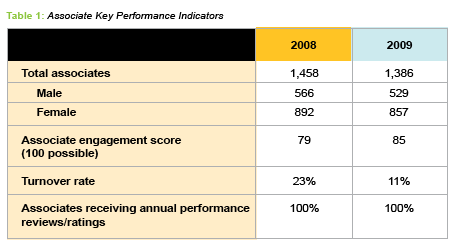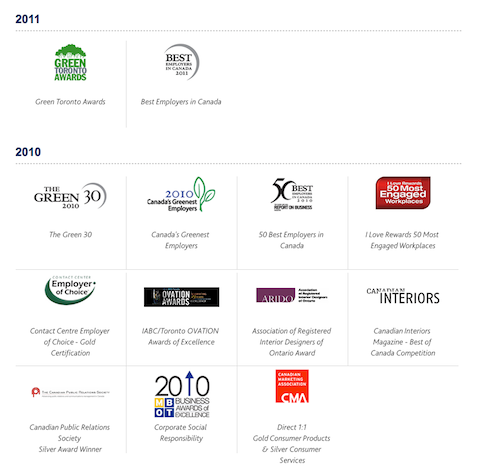 Talents are key to success in today’s business. How much would a company pay to lower staff turnover rate by 12%? Best Employers in Canada winner LoyaltyOne achieved this through going green. I talked to Chief Sustainability Officer Debbie Baxter to see how embedding sustainability into their corporate culture changes the company.
Talents are key to success in today’s business. How much would a company pay to lower staff turnover rate by 12%? Best Employers in Canada winner LoyaltyOne achieved this through going green. I talked to Chief Sustainability Officer Debbie Baxter to see how embedding sustainability into their corporate culture changes the company.
LoyaltyOne operates the popular Air Miles reward program that is used by approximately two-thirds of Canadian households. In 2009, they created a new C-level position, Chief Sustainability Officer. Since then, LoyaltyOne has been accumulating top industry awards, including the coveted Best Employers in Canada presented by The Globe And Mail Report On Business. Other accolades include Green Toronto Awards (City of Toronto), The Green 30, Canada’s Greenest Employers, and Living City Award for Sustainable Communities Leadership.
Internally, staff turnover rate and employee engagement have dramatically improved. According to the company’s accountability report (PDF), staff turnover rate dropped from 23% in 2008 to 11% in 2009, an improvement of 12%. Associate engagement score improved from 79% to 85%. This measures the extent to which “associates are committed, motivated and actively involved in helping the company be successful.” In 2009, 85% of associates said they would “recommend LoyaltyOne as one of the best places to work”, up 6% from 2008. Leader of Hewitt’s Best Employers in Canada study Neil Crawford says “LoyaltyOne has done an excellent job of attracting, retaining and engaging people with a shared passion and excitement for the work they do.”

In other words, LoyaltyOne is retaining talents much more effectively and staff finds it a great place to work. How much would HR pay for a 12% reduction in turnover? MIT Sloan Management estimates each employee’s turnover costs a company up to 150% of the employee’s remuneration package (see Breaking the Cycle of Failure in Services). For a company of 100 staff, for example, the savings could reach over a million. This is no small change.
While LoyaltyOne’s dramatic retention improvement may not be totally attributable to their sustainability initiatives, there is a good case to be made that sustainability brings in real and substantial return on investment.
What does it take to gain such benefits? How can a company use sustainability to attract new talents and retain current ones? I talked to Debbie Baxter, Chief Sustainability Officer of LoyaltyOne, to find out how they embedded sustainability into their corporate culture. What I found is that rather than a few high profile projects, changing culture often means doing many little things that reinforce the message over a long period of time. Here are some notable items.
Leadership on board — LoyaltyOne’s leadership is committed to being corporate social responsibility (CSR) leaders. In the company’s internal townhall meetings, the leadership team frequently talks about their CSR progresses. Staff can sense their leaders’ passion on CSR. And staff can feel proud of the work their leaders are doing.
Internal environmental fair — Once a year, the company hosts an internal environmental fair. Internal meeting rooms act as trade show booths. External vendors bring in their catalogues and showcase their green products to staff.
Internal communication — The weekly internal newsletter to staff always carries a green section showing internal and external news. There are dedicated sustainability communications that are sent to staff a few times a year.
Contests, prizes, giveaways — When the company wins an award, such as The Green 30 award, or when some big news is announced, it holds townhall meetings. Prizes and giveaways are involved, usually they are environmentally friendly products, e.g. scooters. Prizes attract attendance, but the message is reinforced through special ‘green’ prizes.
Education — LoyaltyOne helps staff live sustainable lives, both in and out of the workplace. For example, the company purchased electrical plug meters and allow staff to take the meters home to measure power usage at home. The meters do not cost a lot, but it really shows the leadership wants more than just the company to be sustainable. They would like to see their staff live sustainable lives outside of work, too.
Grassroots initiatives — Sometimes, initiatives are started by staff. One example is using reusable cups instead of disposable ones. This was started by staff getting together on their own during lunch hour. Once the president knew about the initiative, he gave it his full support.
Survey — The company conducts annual survey on employee engagement. Staffs are encouraged to provide comments, offering them a formal feedback channel in addition to the informal ones that happen throughout the year.
Changing corporate culture is not easy. Many companies encounter challenges and LoyaltyOne is no exception. According to Baxter, getting staff’s attention often takes some effort. “Our staff have heavy workload and sometimes it’s not easy to get their attention. We try to make sustainability fun. So we don’t usually focus on the scientific theory aspects. We try to use fun and games to get their attention.”
All of these initiatives cost money. Finding budget for such initiatives is often a challenge faced by sustainability champions. For this, LoyaltyOne’s leadership takes a different view. “A major concern in running our business is in how to attract and retain talents. This is probably true for many companies in today’s economy. We see the costs on our CSR efforts as spending to attract and retain talents. We needed to market our company to attract talents anyway. We think talents are attracted to industry leaders. Being regularly profiled in the news for our CSR work really helps us gain a glowing reputation which in turn attracts talents.”
Being socially responsible, winning top employer awards, lowering staff turnover rate … it’s not hard to connect the dots. These are real and substantial business ROI from sustainability. Saving the environment is almost just a bonus.
Images courtesy of LoyaltyOne


Top Talents Attracted by Corporate Social Responsibility http://bit.ly/iLmdid #csr #sustainability #hr
Top Talents Attracted By Corporate Social Responsibility http://t.co/OJoT8by via @AddToAny
Top Talent Attracted By Corporate Social Responsibility http://t.co/HZ2Mx4L
[英文] カナダの会社の事例。「トップ人材はCSRに注力する企業にひきつけられる」 Top Talents Attracted By Corporate Social Responsibility http://bit.ly/moKYnx via Carbon49
[…] Collaboration often means stepping outside your comfort zone and reaching out to other groups, whether internal to the company or with external organizations. While this may feel uneasy at first, global leaders have shown that win-win collaboration is a key to unlocking more values from sustainability initiatives. Canada can be proud to claim a leadership position in driving operational efficiency and cost reduction. Now is the time to build longer term values and seize the next phase of rewards in organizational reputation, customer loyalty, corporate culture, and employee engagement. […]
[…] dramatically reduced their staff turnover rate through employee engagement initiatives (see this post for more details). Whether you are planning for staff environmental fairs, contests with a green […]
[…] likes a new building, RBC builds their new headquarters with specific business objectives in mind: attract and retain talents, reduce operational and environmental footprint, foster team collaboration, and further their […]
[…] their more engaged employees drastically lower turnover rate and brought big savings? (See: LoyaltyOne lower staff turnover rate by 12% and Employee Engagement Drives Sustainability Strategy.) I don’t know why. I don’t know […]
[…] because their more engaged employees drastically lower turnover rate and brought big savings? (See:LoyaltyOne lower staff turnover rate by 12% and Employee Engagement Drives Sustainability Strategy.) I don’t know why. I don’t know the […]
[…] their more engaged employees drastically lower turnover rate and brought big savings? (See: LoyaltyOne lower staff turnover rate by 12% and Employee Engagement Drives Sustainability Strategy.) I don’t know why. I don’t know the […]
[…] Employee engagement has a ripple effect and creates numerous benefits, including higher innovation, lower turnover, reduced sick days and absenteeism, higher employee morale, increased productivity, better retention, improved talent attraction. (See how LoyaltyOne lower their staff turnover rate by 12% by going green.) […]
[…] Collaboration often means stepping outside your comfort zone and reaching out to other groups, whether internal to the company or with external organizations. While this may feel uneasy at first, global leaders have shown that win-win collaboration is a key to unlocking more values from sustainability initiatives. Canada can be proud to claim a leadership position in driving operational efficiency and cost reduction. Now is the time to build longer term values and seize the next phase of rewards in organizational reputation, customer loyalty, corporate culture, and employee engagement. […]